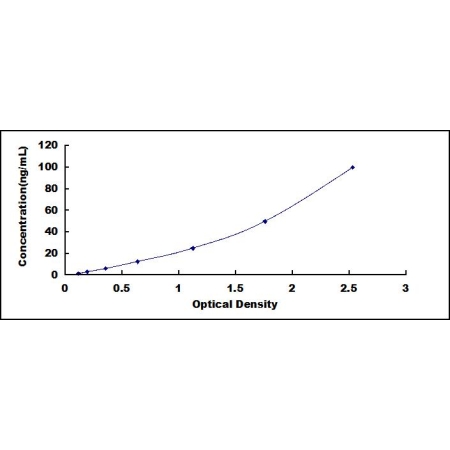Clinisciences > HSPA1A ELISA Kit (Bovine)
HSPA1A ELISA Kit (Bovine)
Marca : Aviva Systems Biology
Solicitar más información
Por favor, inicie sesión para usar esta función.
| Datasheets/Manuals | Printable datasheet for HSPA1A ELISA Kit (Bovine) (OKCD07121) |
|---|
| Predicted Species Reactivity | Bos taurus|Bovine | ||||||||||||||||||||||
|---|---|---|---|---|---|---|---|---|---|---|---|---|---|---|---|---|---|---|---|---|---|---|---|
| Application | ELISA-Sandwich | ||||||||||||||||||||||
| ELISA Kit Detection Method | Colorimetric | ||||||||||||||||||||||
| ELISA Kit Duration | 3h | ||||||||||||||||||||||
| ELISA Kit Principle | The test principle applied in this kit is Sandwich enzyme immunoassay. The microtiter plate provided in this kit has been pre-coated with an antibody specific to Heat Shock 70kDa Protein 1A (HSPA1A). Standards or samples are then added to the appropriate microtiter plate wells with a biotin-conjugated antibody specific to Heat Shock 70kDa Protein 1A (HSPA1A). Next, Avidin conjugated to Horseradish Peroxidase (HRP) is added to each microplate well and incubated. After TMB substrate solution is added, only those wells that contain Heat Shock 70kDa Protein 1A (HSPA1A), biotin-conjugated antibody and enzyme-conjugated Avidin will exhibit a change in color. The enzyme-substrate reaction is terminated by the addition of sulphuric acid solution and the color change is measured spectrophotometrically at a wavelength of 450nm +/- 10nm. The concentration of Heat Shock 70kDa Protein 1A (HSPA1A) in the samples is then determined by comparing the O.D. of the samples to the standard curve. | ||||||||||||||||||||||
| ELISA Kit Range | 1.56-100ng/mL | ||||||||||||||||||||||
| ELISA Kit Reproducibility | Intra-assay Precision (Precision within an assay): 3 samples with low, middle and high level Heat Shock 70kDa Protein 1A (HSPA1A) were tested 20 times on one plate, respectively. Inter-assay Precision (Precision between assays): 3 samples with low, middle and high level Heat Shock 70kDa Protein 1A (HSPA1A) were tested on 3 different plates, 8 replicates in each plate. CV(%) = SD/meanX100 Intra-Assay: CV<10% Inter-Assay: CV<12% | ||||||||||||||||||||||
| ELISA Kit Component |
| ||||||||||||||||||||||
| Reconstitution and Storage | 2°C to 8°C|-20°C | ||||||||||||||||||||||
| Sample Type | Serum, plasma, tissue homogenates, cell lysates, cell culture supernates and other biological fluids | ||||||||||||||||||||||
| Sensitivity | < 0.56ng/mL |
| Gene Symbol | HSPA1A |
|---|---|
| Gene Full Name | heat shock protein family A (Hsp70) member 1A |
| Alias Symbols | 70 kda heat shock protein-2;chaperone;heat shock 70 kD protein 1;heat shock 70 kD protein 2;heat shock 70 kDa protein 1;heat shock 70 kDa protein 1A;heat shock 70 kDa protein 1B;heat shock 70 kDa protein 2;heat shock 70kDa protein 1A;heat shock 70kDa protein 1B;Heat Shock Protein 70;heat-shock 70-kilodalton protein 1A;heat-shock 70-kilodalton protein 1B;HSP70;HSP70.1;HSP70.2;HSP70-1;HSP70-2;HSPA1;HSPA1B;HSPA2. |
| NCBI Gene Id | 282254 |
| Protein Name | Heat shock 70 kDa protein 1A |
| Description of Target | Molecular chaperone implicated in a wide variety of cellular processes, including protection of the proteome from stress, folding and transport of newly synthesized polypeptides, activation of proteolysis of misfolded proteins and the formation and dissociation of protein complexes. Plays a pivotal role in the protein quality control system, ensuring the correct folding of proteins, the re-folding of misfolded proteins and controlling the targeting of proteins for subsequent degradation. This is achieved through cycles of ATP binding, ATP hydrolysis and ADP release, mediated by co-chaperones. The co-chaperones have been shown to not only regulate different steps of the ATPase cycle, but they also have an individual specificity such that one co-chaperone may promote folding of a substrate while another may promote degradation. The affinity for polypeptides is regulated by its nucleotide bound state. In the ATP-bound form, it has a low affinity for substrate proteins. However, upon hydrolysis of the ATP to ADP, it undergoes a conformational change that increases its affinity for substrate proteins. It goes through repeated cycles of ATP hydrolysis and nucleotide exchange, which permits cycles of substrate binding and release. The co-chaperones are of three types: J-domain co-chaperones such as HSP40s (stimulate ATPase hydrolysis by HSP70), the nucleotide exchange factors (NEF) such as BAG1/2/3 (facilitate conversion of HSP70 from the ADP-bound to the ATP-bound state thereby promoting substrate release), and the TPR domain chaperones such as HOPX and STUB1. Maintains protein homeostasis during cellular stress through two opposing mechanisms: protein refolding and degradation. Its acetylation/deacetylation state determines whether it functions in protein refolding or protein degradation by controlling the competitive binding of co-chaperones HOPX and STUB1. During the early stress response, the acetylated form binds to HOPX which assists in chaperone-mediated protein refolding, thereafter, it is deacetylated and binds to ubiquitin ligase STUB1 that promotes ubiquitin-mediated protein degradation. Regulates centrosome integrity during mitosis, and is required for the maintenance of a functional mitotic centrosome that supports the assembly of a bipolar mitotic spindle. Enhances STUB1-mediated SMAD3 ubiquitination and degradation and facilitates STUB1-mediated inhibition of TGF-beta signaling. Essential for STUB1-mediated ubiquitination and degradation of FOXP3 in regulatory T-cells (Treg) during inflammation. Negatively regulates heat shock-induced HSF1 transcriptional activity during the attenuation and recovery phase period of the heat shock response. |
| Uniprot ID | Q27975 |
| Protein Accession # | NP_776975.1 |
| Nucleotide Accession # | NM_174550.1 |
-
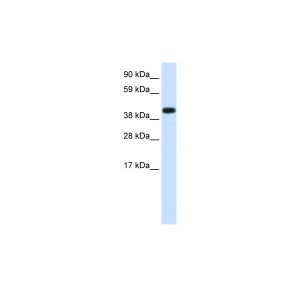 HSPA1A Antibody - middle region (ARP33096_T100)Catalog #: ARP33096_T100Species Tested: HumanApplication: WBFormat: Liquid. Purified antibody supplied in 1x PBS buffer with 0.09% (w/v) sodium azide and 2% sucrose.
HSPA1A Antibody - middle region (ARP33096_T100)Catalog #: ARP33096_T100Species Tested: HumanApplication: WBFormat: Liquid. Purified antibody supplied in 1x PBS buffer with 0.09% (w/v) sodium azide and 2% sucrose. -
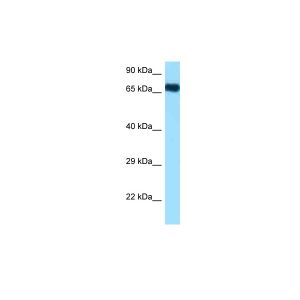 Hspa1a Antibody - N-terminal region (ARP61005_P050)Catalog #: ARP61005_P050Species Tested: Mouse, PigApplication: WBFormat: Liquid. Purified antibody supplied in 1x PBS buffer with 0.09% (w/v) sodium azide and 2% sucrose.
Hspa1a Antibody - N-terminal region (ARP61005_P050)Catalog #: ARP61005_P050Species Tested: Mouse, PigApplication: WBFormat: Liquid. Purified antibody supplied in 1x PBS buffer with 0.09% (w/v) sodium azide and 2% sucrose. -
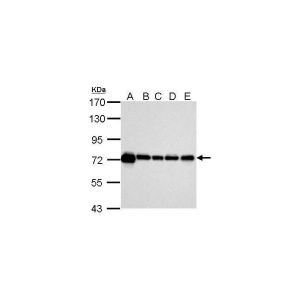 HSPA1A Antibody (OAGA00883)Catalog #: OAGA00883Application: ICC, IF, IHC-P, WBFormat: Liquid 1XPBS, 20% glycerol (pH 7) with 0.01% Thimerosal added as a preservativeSize: 100 ul
HSPA1A Antibody (OAGA00883)Catalog #: OAGA00883Application: ICC, IF, IHC-P, WBFormat: Liquid 1XPBS, 20% glycerol (pH 7) with 0.01% Thimerosal added as a preservativeSize: 100 ul -
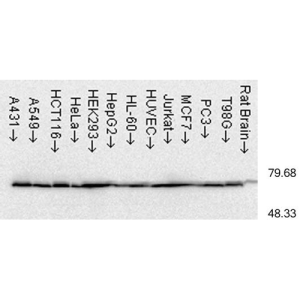 Hsp70 Antibody (OASE00002)Catalog #: OASE00002Conjugation: UnconjugatedClone: C92F3A-5Application: AM, Blk, ELISA, FACS, FC, ICC, IEM, IF, IHC, WBFormat: Liquid. PBS (pH 7.4) with 50% glycerol and 0.1% sodium azideSize: 200ug
Hsp70 Antibody (OASE00002)Catalog #: OASE00002Conjugation: UnconjugatedClone: C92F3A-5Application: AM, Blk, ELISA, FACS, FC, ICC, IEM, IF, IHC, WBFormat: Liquid. PBS (pH 7.4) with 50% glycerol and 0.1% sodium azideSize: 200ug -
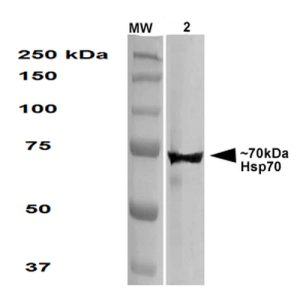 Hsp70 Antibody (OASE00021)Catalog #: OASE00021Conjugation: UnconjugatedClone: 1.86Application: ELISA, ICC, IF, WBSize: 50ug
Hsp70 Antibody (OASE00021)Catalog #: OASE00021Conjugation: UnconjugatedClone: 1.86Application: ELISA, ICC, IF, WBSize: 50ug
This product can not be ordered from your electronic catalog. A quotation will be created for this reference, would you like to continue? In this case, make sure that you have filled in the desired quantity




